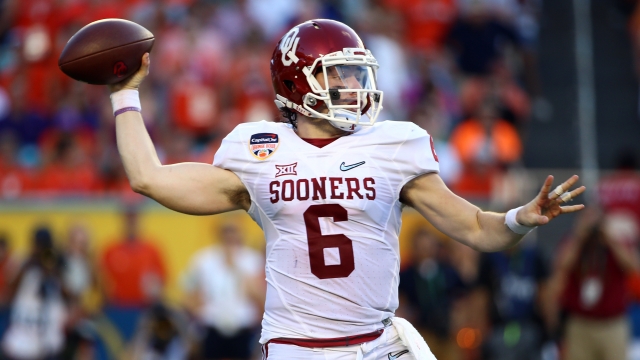
Matt Waldman’s Rookie Scouting Portfolio examines a red zone play from QB Baker Mayfield’s Rose Bowl performance.
Providing a glimpse into the Rookie Scouting Portfolio game evaluation process, I shared multiple video clips on Twitter of Baker Mayfield’s Rose Bowl performance. Mayfield had a phenomenal senior campaign at Oklahoma and his stats are eye-popping — especially the volume of long plays that he authored in the Sooners offense.
At least that’s how it appears on the surface.
The volume of long plays doesn’t count where pass completions occur relative to the line of scrimmage. It’s easy for fans to make the wrong assumption about a quarterback’s play if they mistakenly presume that these long plays mostly begin with a completion 20-30 yards from the line of scrimmage when a healthy percentage of them are well-designed and well-executed run play substitutes:
- screens
- pop-passes
- shovel passes
- throw-outs to receivers at the line of scrimmage
- misdirection plays that lead to short passes speedy receivers like Marquise ‘Hollywood’ Brown into open swaths of grass
While I haven’t tallied the volume splits for the examples above, I would be shocked if less than 25 percent of Mayfield’s long pass plays were of this variety. I wouldn’t be surprised if they accounted for 35-45 percent of his big-play completions.
Production statistics are a terrific gateway into a player’s game but at some point, you have to get into the weeds. Although some statistics will help accomplish that task, I’m focused on the film.
Another stat-film dynamic about Mayfield worth broaching is his accuracy. Look at his completion percentage and one could make the assumption that Mayfield is an accurate quarterback for an NFL prospect.
While I have more of Mayfield’s tape to study, I’ve seen enough games to at least tell you that the above assumption is at least too simplistic and could be a troublesome one.
The NFL standard for accuracy is pinpoint — placing the ball in-stride to a receiver so the need for an adjustment to the target is minimal or strategic (for example, throwing open a tightly covered receiver in a spot where only the receiver can make the play — even if it requires an athletic effort). There are also several situations to judge accuracy:
- The distance of the target from the pitch-point.
- Designed movements like rollouts and sprints.
- Targets in the rhythm of a drop and hitches tied to the timing of routes.
- Targets when the rhythm of the route breaks down.
- Targets under pressure.
- Targets from an off-balanced position.
- Red zone accuracy.
If accuracy isn’t broken down by the situation, it’s difficult to get a true feel of where and when a quarterback excels and struggles and which routes and schemes are best suited for him.
I shared a variety of clips from Mayfield’s performance and the least-watched video (before I retweeted it and noted what I’m noting here) from my analysis was the one I found most telling about the quarterback:
Example
Good manipulation of LB, good accuracy, but about 2 beats late on decision and kills WRs chance for less contested catch pic.twitter.com/yfagMxSdhi
— Matt Waldman (@MattWaldman) January 17, 2018
https://platform.twitter.com/widgets.js
After watching the video again, if you count Mayfield’s two beats of his feet hopping from the ground, his step into his throw, and the beat it took to get rid of the ball, that’s actually about the same amount of time it would take a receiver to cover four steps.
Look at the video and consider the receiver catching the pass four steps earlier in his break. Look where the cornerback is and look where the safety isn’t. While Mayfield was pinpoint accurate with the placement of the ball, he was only accurate to the letter of the term.
The best quarterbacks are accurate to the letter and the spirit of the term. Red zone quarterbacking requires an increased tempo for decision-making. There’s a lot less field for the defense to cover which means the windows are tighter.
Tighter windows mean less there’s less time to make a decision. While there are always exceptions to the rule, quarterbacks cannot hesitate when they spot an open receiver. They must recognize the favorable leverage position between the receiver and the defender and act in rhythm.
The red zone example above is a common issue for many NFL prospects and young starters and not a career-killer for Mayfield. It’s a good presentation point for those interested in quarterback development.
Based on the film I’ve studied up to this point, Mayfield is most accurate in the rhythm of a quick-hitting play with single reads where the manipulation of a defender is baked into the beginning of the play or when Mayfield abandons the pocket and runs scramble drills.
When forced create his own rhythm within the original structure of the play design because something —and in football, something often does —goes wrong, Mayfield struggles.
I have a lot more to see, but hopefully, this lends some insight into Mayfield, NFL quarterback prospects, and why catch-all terms like ‘accuracy’ can be deceiving.
For analysis of skill players, get the 2018 Rookie Scouting Portfolio, now available for pre-order. If you’re a fantasy owner the Post-Draft Add-on comes with the 2012 – 2018 RSPs at no additional charge. Best, yet, 10 percent of every sale is donated to Darkness to Light to combat sexual abuse. You can purchase past editions of the Rookie Scouting Portfolio for just $9.95 each.

